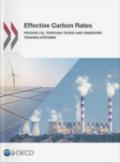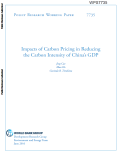This paper defines the ‘2°C capital stock’ as the global stock of infrastructure which, if operated to the end of its normal economic life, implies global mean temperature increases of 2°C or more (with 50% probability). Using IPCC carbon budgets and the IPCC’s AR5 scenario database, and assuming future emissions from other sectors are compatible with a 2°C pathway, the researchers calculate that the 2°C capital stock for electricity will be reached by 2017 based on current trends. In other words, even under the very optimistic assumption that other sectors reduce emissions in line with a 2°C target, no new emitting electricity infrastructure can be built after 2017 for this target to be met, unless other electricity infrastructure is retired early or retrofitted with carbon capture technologies. Policymakers and investors should question the economics of new long-lived energy infrastructure involving positive net emissions.

This report provides the first progress assessment of climate actions launched at the 2014 UN Climate Summit in New York. It considers the distribution and performance of climate actions along multiple dimensions that are relevant to both mitigation and adaptation. While it is too early for a conclusive assessment of the effectiveness of climate actions, this study makes a first and indispensable step toward such an assessment. Initial findings are encouraging. One year after their launch, most climate actions have performed well in terms of producing outputs, putting them on track to implementing their commitments in the coming years.

As countries negotiated a new climate agreement for the United Nations climate conference in December 2015, a groundswell of climate actions emerged as cities, regions, businesses and civil society groups act on mitigation and adaptation, independently, with each other and with national governments and international organizations. The Paris conference provided a historic opportunity to establish a framework to catalyse, support, and steer these initiatives. Without such a framework, ‘bottom-up’ climate governance runs the risk of failing to deliver meaningful results. Social science research highlights the need for a comprehensive approach that promotes ambition, experimentation and accountability, and avoids unnecessary overlaps. This article specifies functions and design principles for a new, comprehensive framework for sub- and nonstate climate actions that could provide effective coordination.

In contributing to global climate change mitigation efforts as agreed in Paris in 2015, China has set a target of reducing the carbon dioxide intensity of gross domestic product by 60-65 percent in 2030 compared with 2005 levels. Using a dynamic computable general equilibrium model of China, this study analyzes the economic and greenhouse gas impacts of meeting those targets through carbon pricing. The study finds that the trajectory of carbon prices to achieve the target depends on several factors, including how the carbon price changes over time and how carbon revenue is recycled to the economy. The study finds that carbon pricing that starts at a lower rate and gradually rises until it achieves the intensity target would be more efficient than a carbon price that remains constant over time. Using carbon revenue to cut existing distortionary taxes reduces the impact on the growth of gross domestic product relative to lump-sum redistribution. Recycling carbon revenue through subsidies to renewables and other low-carbon energy sources also can meet the targets, but the impact on the growth of gross domestic product is larger than with the other policies considered.
